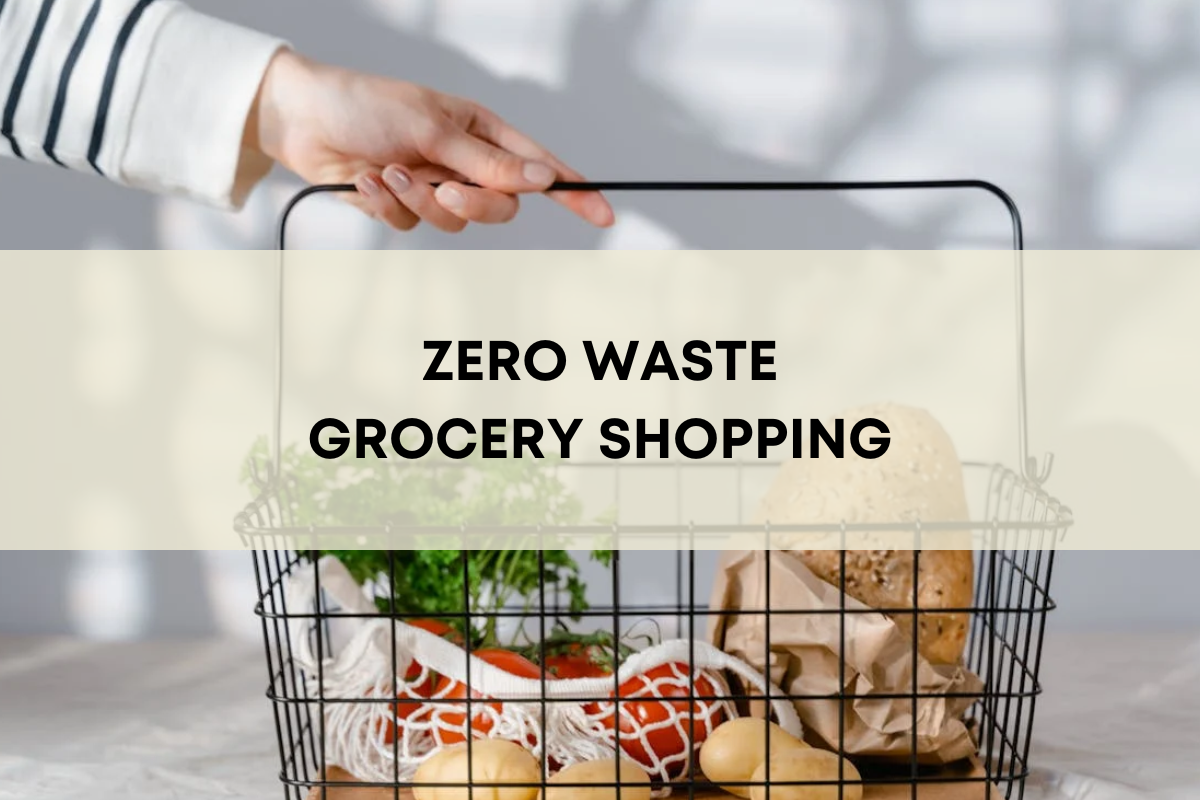Zero Waste Grocery Shopping

This post is part of our “Green Your Routine” series, which aims to share a handful of swaps you can make to reduce waste in a specific area of your life. These suggestions are not intended to be all-encompassing, but rather should serve as a springboard for you to think creatively about how you might reuse or repurpose what you already have and what sustainable alternatives you might replace those items with once they wear out.
A few years ago, there was an image circulating around the internet of a mason jar filled with trash. This tiny jar represented the amount of trash sent to landfill by one person living zero waste over the course of a year– an entire year! As inspiring as that is, for many of us, it’s quite daunting and frankly, unrealistic. It’s important to have goals in your zero waste journey and to consistently strive for better, but as author Anne-Marie Bonneau says, “We don’t need a handful of people doing zero waste perfectly. We need millions of people doing it imperfectly.” It doesn’t matter how you start– just start now, and start somewhere.
First up… let’s talk about how to green your grocery shopping routine. There are many easy ways we can make our grocery shopping experiences more eco-friendly with a little planning and preparation. The best part is you can shop more sustainably using items you probably already own.

Make Your Zero Waste Shopping Kit
Creating a zero waste shopping kit is a step towards ensuring you are alway prepared to shop your grocery store in a sustainable way. Want help getting started? Check out our Market Bundle– it’s got all the essentials.
Key items to include in your zero waste kit are:
- Reusable totes.
- Cotton or mesh produce bags (Bonus: these bags can double as laundry bags, perfect for washing small items like facial rounds or delicates.)
- Containers to refill: mason jars, bottles, Stasher bags, repurposed food containers (ex. plastic takeout containers, yogurt tubs, nut butter jars, etc.)
Keep your zero waste shopping kit where you will need it– in your car, in the pocket of your backpack, or on a hook by your front door. Maybe you need to make multiple shopping kits! The goal is to have your reusables with you when you need them without much extra effort or planning. This may take some trial and error, but you will find a routine that works for you in time.
Skip Single-Use Bags
It is estimated that the average American household will accumulate approximately 1,500 single-use shopping bags each year. Plastic bags are not biodegradable; they break down into smaller pieces (microplastics) over time and leach toxic chemicals into our fragile ecosystems. While paper bags are often seen as environmentally superior to plastic due to their compostability, significant energy, resources, and chemicals are still used to create them (1).
This is why reusable bags are an essential in your zero waste shopping kit. Anytime we refuse a new item because we are reusing an existing item, we reduce the demand for creation of new items, thus reducing our overall consumption of energy and raw materials. The more times you reuse your bags, the lower their carbon footprint will be!
Utilize The Bulk Section
Over 400 million tons of plastic are produced globally each year. Roughly half of this is for single use items (2), and about 36% is packaging (3). Since everything produced requires energy and resources, by reducing the number of packaged items you purchase, you are reducing your environmental impact.
Many grocery stores offer a bulk section with unpackaged non-perishable grocery items, cleaning products, and personal care products. By bringing your own containers for bulk shopping and refilling them over and over, you should notice a significant decrease in the amount of trash or recycling you're wheeling out to the curb.
While it’s tempting to buy shiny new containers to fill, it’s more sustainable to reuse existing items like mason jars, yogurt tubs, peanut butter jars, and soap bottles– search your house and get creative with items you already have.
Can’t find anywhere local to shop in bulk? Check out our bulk offerings and have sustainable, package-free goods shipped right to your door. Even our shipping materials are repurposed. Once you receive your order, take advantage of our Return & Reuse program.
Choose Glass & Aluminum Over Plastic
When it is not possible to purchase an item in bulk, consider packaged options carefully. It’s generally better to opt for items packaged in aluminum or glass over plastic.*
Almost all plastics have the “recycle” symbol on them, but only 5-6% of plastics are actually recycled in the US, and as they are recycled, they degrade in quality. Glass and aluminum, on the other hand, can be infinitely recycled. This means that to produce plastic, virgin materials (derived from fossil fuels) are continually being looped into production cycles, whereas glass and aluminum packing can be more reliant on recycled materials.
*Note: Sustainability is challenging to assess when you consider all aspects of production and distribution. In this post, we are focusing on the post-consumer environmental impacts and recycling potential of these materials.
Recent Blog Posts
Discover more tips on living #ZeroWaste!
-

10 Tips for a Zero Waste Summer
Summer fun doesn't have to create summer waste. These 10 zero waste tips help you reduce your footprint while still enjoying sunshine, picnics, and travel.
Read more -

10 Things You Didn't Know You Could Compost
Composting can significantly reduce the waste we send to landfills and provide nutrient-rich soil for gardens. Did you know that you can compost things like wooden skewers, pizz...
Read more -

How to Celebrate Earth Month: 10 Actions to Make a Difference
Earth Month is the perfect time to take action for the planet. In this post, we share 10 simple actions you can take this month to celebrate Earth Month and reduce your ecologic...
Read more



